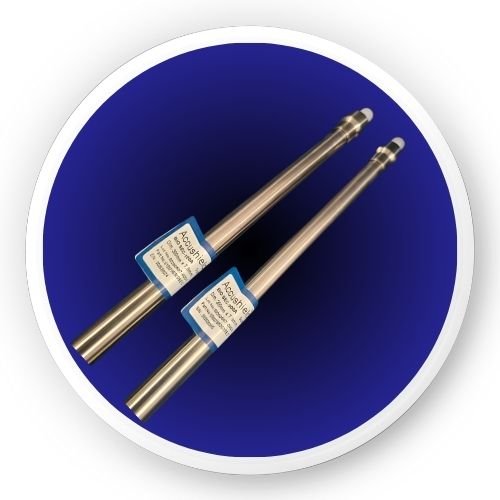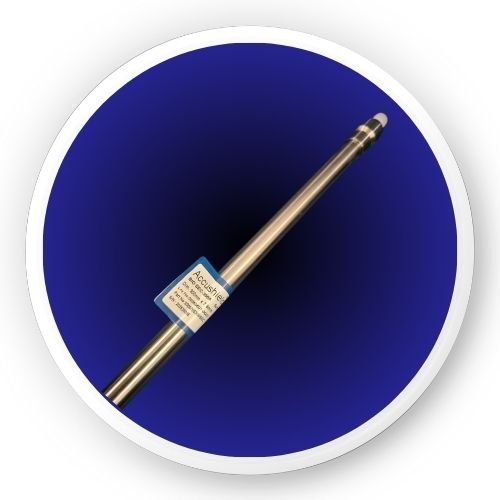Accushield Bio SEC
Accushield Bio SEC
Accushield Bio SEC 300A and Accushield Bio SEC 120A column is as a size exclusion chromatography (SEC) column specifically designed for separation, Molecular weight estimation and characterization of different class of molecules that includes but not limited to peptide, protein, monoclonal antibodies, fusion protein and ADC (Antibody drug conjugates’). The Accushield Bio SEC 300A and Accushield Bio SEC 120A is based on high purity spherical porous silica column that are synthesized using patented technology in a way that silica particle has minimal to minimal secondary interaction with molecules under analysis. Modified silica particle also help to withstand different eluent conditions that are required for analysis such as mobile phase with high and low ionic strength as well as mass spectrometry compatible mobile phases. Separation mechanism in Accushiled Bio SEC is very similar to conventional SEC i.e molecules are separated depending upon the hydrodynamic radii of the molecules. On the SEC column depending upon selection of pore size of column, very large analytes (>1000 kDa) are excluded by pore where as large molecules elute earlier compared to small molecules. More clearly it can be understood from below figures.

Accushield Bio SEC 300Å

Accushield Bio SEC 120Å
Working principle for SEC:
Accuedge Separation provides two different variants in Bio SEC range both ranges differ in pore size of column AccushieldBio SEC 300A is a 300 A Pore size column, while AccushieldBio SEC 120A is 120 A pore size column.
Accushield Bio SEC 300A/ Accushield Bio SEC 120Acolumn: Accushield Bio SEC 300Ais anoptimized SEC phase required for biomolecules analysis. This column is highly recommended for analysis of complex large molecules that includes proteins, nucleic acids, peptides, enzymes, ADC drugs, and monoclonal antibodies (mAbs)column can also be used for routine testing of water-soluble polymers, PEG, polysaccharides, and other hydrophilic macromolecules
Suitable for synthetic peptides and large molecules with molecular weights from 100 Da up to 3,500,000 Da
Accushield Bio SEC 300A / Accushield Bio SEC 120Aused specialised Silica stationary phasethat has minimal to minimal secondary interaction with large molecules like protein and peptide so as to deliver more consistent and best result even in presence of mild or no modifier. This in turn help to increase the life of column compared to another well-known pierce competitor. Special bonding process provides ultra-low adsorption and batch-to-batch consistency.
Accushield Bio SEC 300A / Accushield Bio SEC 120Ais two different pore size variants in SEC range 120A and 300A. Depending upon class of molecules followed by size of molecules, scientist can select one of variants of pore size.
Operating Limit and Specification:
Flow rate range (recommended) | 0.2ml/ min or less for column ID 4.6mm or less while 0.5 ml/min for 7.8mm ID and larger ID |
Shipping solution/ long term storage solution | Methanol/70% ACN in water |
Typical buffers | Phosphate buffer with NaCl, e.g. 50 mM phosphate buffer (pH 6.8) + 0.3 M NaCl Good’s buffer with NaCl, e.g. 20 mM MES buffer (pH 6.1) + 0.3 M NaCl Ammonium formate or ammonium acetate solutions, pH 5 – 7 |
Solvents compatibility | Compatible with 100% Acetonitrile solvent |
Temperature range | 10-30C |
Pressure limit | Less than 400 bar |
pH range | 2-8 |
Getting Started with column:
- Observe the column for any physical damages if any during transport. Accuedge Separation further recommend to perform column performance test upon receiving of the column to ensure there is no damage during shipping.
- Test the column using the conditions as per mentioned on the Quality Assurance (QA) report enclosed in the column box. Repeat the test periodically to track the column performance over time. Note that slight variations may be found on two different HPLC systems due to system electronic, hardware, plumbing, operating environment, reagent quality, column conditioning, and operator technique.
Visually inspection of the column:
Report any visible damage upon receiving the column to Accuedge separation immediately. Depending upon the nature of the damage, we may request that you return the damaged column back to us for a replacement of the column. - Selection of Mobile phase for analysis:
The Accushield Bio SEC 300A / Accushield Bio SEC 120Acan be used with a variety of mobile phases. The columns are normally used with 20 – 100 mM buffer (pH 5.0 – 7.5) containing 0.1 – 0.3 M salt. A typical mobile phase for monoclonal antibodies separations is 30-50 mM phosphate buffer (pH 6.9) + 0.3-0.5M NaCl. Ammonium formate and ammonium acetate buffer can also be used when coupling the column to a mass spectrometer and a volatile buffer is needed, in which case 75 mM buffer concentration is a good starting point. Depending upon application ACN along with Formic acid and small amount of TFA is also a better choice of mobile phase for MS compatible application. It is highly recommended that the mobile phase is pre-filtered with a 0.2 μm pore size membrane filter, or/and an in-line filter containing installed membrane on HPLC system.
- Operating guideline for SEC column
Observe the direction of flow while connecting to HPLC system. Any sudden surges of pressure will disturb the bed material of Sec and make it irreversible damages to column which will be not possible to regenerate.
Any new column upon receiving require to replace the shipping solvent with sequential washing of ACN water mixture in a ratio of (90% ACN in water for 20-30 column volumes i.eatleast 5 hr at 0.5ml/min flow rate for 7.8mm ID and 0.2 ml /min for 4.6 mm ID). If the analysis of method required to use mobile phase with salt it is highly recommended to further replace shipping solvent which is 100 % methanol with water before proceeding for analysis with salt or non-volatile buffer.
Column is required than to saturate with atleast 10-15 Column volume of mobile phase before injecting first injection.
Column conditioning is recommended upon initial column use: inject 4 successive injections of the sample, or 150μg BSA, or other proteins of choice before beginning of analysis this will help to block non-specific interacting site of column. This will also help to get consistent data.
Reverse flow of column should be avoided except for removal of inlet blockage and cleaning of column.
Call to Action
Explore your design idea and make your entire website absolutely stunning!
Have Specific Requirements? We will help you to find a Perfect Solution!
Our team is ready to provide personalized assistance and help you choose the right solution for your analytical needs.
- +91 90166 18537
- info@accuedgesep.com
